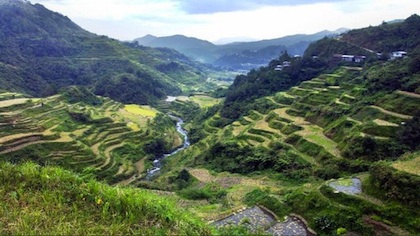SUMMARY
This is AI generated summarization, which may have errors. For context, always refer to the full article.

MANILA, Philippines – The Rice Terraces are safe.
The World Heritage Committee has stricken off its danger list the renowned Rice Terraces in the Cordilleras in Ifugao. It was put on the Danger List in 2001 in response to a request by the Philippine government.
The terraces were put on the World Heritage List in 1995, recognizing it as an outstanding cultural landscape. Built about 2,000 years ago, the terraces span 4 municipalities and consist of 5 clusters – Nagacadan, Hungduan, Mayoyao, Bangaan, and Batad.
The United Nations Educational, Scientific and Cultural Organization (Unesco) has said the Rice Terraces are the “priceless contribution of Philippine ancestors to humanity.”
They “epitomize the absolute blending of the physical, socio-cultural, economic, religious, and political environment. Indeed, it is a living cultural landscape of unparalleled beauty.”
The United Nations Information Center said the “List of World Heritage in Danger” was drawn up to inform the international community of “threats to the outstanding universal values of sites incribed on the World Heritage List.” The list was designed to “encourage corrective action and support.”
The UN said preservation of the Philippine jewel required “better management and development” on top of increased national and international support. “Both actions were successfully undertaken, leading to the conservation of the remote high rice fields.”
National treasure
The Terraces were declared national treasures via two presidential decrees in 1973 and 1978. They are likewise protected by Republic Act 10066 of 2010, which provided for the protection and conservation of the National Cultural Heritage.
Modernization, migration, massive earthquakes, changes in the management of the watershed forests have made the Terraces highly vulnerable.
According to Unesco, in the face of these threats, “sustained efforts shall have to be carried out by the government and the concerned national agencies to ensure its long term sustainability and conservation.”
In a statement, Presidential Spokesman Edwin Lacierda welcomed the removal of the Rice Terraces from the List of World Heritage in Danger. “This is a victory for the joint public and private sector initiative to protect one of our most valuable natural treasures, which in 1995 became the first-ever property to be inscribed in the cultural landscape category of the World Heritage List.”
Over the years, he said, “the collaboration between government and other private stakeholders has systematically conserved the rice terraces and its watersheds, while promoting or re-introducing the site’s ancestral traditions that are crucial to its sustained development.”
Lacierda called attention to the efforts of the local government, too. “We commend the efforts of the Ifugao Provincial Government, its Ifugao Cultural Heritage Office, the Unesco NatCom and other agencies that have contributed to this continuing success. With this reclassification and future responsible stewardship, Filipinos may take pride once more in having one of our own as a globally-recognized and important cultural landscape.”
Besides the Rice Terraces, Pakistan’s Fort and Shalamar Gardens were also taken off the “List of World Heritage in Danger.” The fort contains marble palaces and mosques decorated with mosaics and gilt. According to Unesco, “the elegance of these splendid gardens, built near the city of Lahore on three terraces with lodges, waterfalls and large ornamental ponds, is unequalled.”
The Gardens made it to the Heritage List in 1981 and were marked as endangered in 2000 at the request of the Pakistani government due to urban encroachment. – Rappler.com
You might like:
- Of adventures and misadventures in the Philippines
- Building the future we need
- A promise to leave no trace
Elsewhere in Rappler:
Add a comment
How does this make you feel?
There are no comments yet. Add your comment to start the conversation.